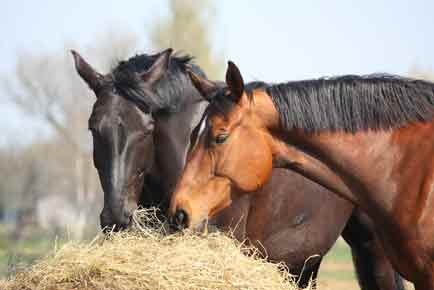The Essential Guide to Different Types of Hay for Animal Feed
Choosing the right type of hay from the different types of hay for your animals is crucial for their health and well-being. Hay is not just a filler; it’s a major component of many animals’ diets, providing necessary nutrients and fiber. This guide will walk you through the different types of hay available, including alfalfa, timothy, and orchard grass, to help you make informed decisions about your types of hay for horses or other animals.

(Two horses eating hay)
Types of Hay OHana Farms Offers
1. Alfalfa Hay
- Alfalfa hay is rich in protein, vitamins, and minerals, making it a highly nutritious option for animals. It’s particularly high in calcium and vitamin K.
- Best For: Ideal for young, growing animals, nursing mothers, or animals that need a high-protein diet. It’s commonly fed to horses, dairy cows, goats, sheep, and rabbits.
- Considerations: Due to its high protein and calcium content, it might not be suitable for all animals, especially those prone to obesity or urinary issues.
- Feed as requirements for every animal and figuring out what they need will help find the best hay for them.
2. Timothy Hay
- Timothy hay is a grass hay known for its high fiber and lower protein content. It comes in different cuts, with the first cut being coarser and the second or third cuts being softer and leafier.
- Best For: Timothy hay is a staple for horses and is also one of the perfect types of hay for rabbits, guinea pigs, and other small herbivores. It helps in maintaining a healthy digestive system and preventing obesity.
- Considerations: While nutritious, it’s less calorie-dense than alfalfa, so it may not be suitable for animals with higher energy requirements.
3. Orchard Grass
- Orchard grass is a soft, leafy, and palatable grass hay, similar to timothy but slightly higher in calories and protein.
- Best For: This hay is a good alternative for animals that do not tolerate the coarseness of timothy hay. It’s suitable for horses, rabbits, guinea pigs, and other small animals.
- Considerations: Its nutritional value can vary greatly depending on when it was harvested, so it’s important to source it from a reliable supplier.
4. Other Types of Hay Bale Feed
- Bermuda Grass: Popular in warmer climates, lower in protein and calories.
- Bluegrass and Ryegrass: Often found in horse pastures and hay mixes, good for general feeding.
Understanding Hay Quality
Understanding the quality of hay is crucial for livestock health and nutrition. Hay quality can vary significantly based on factors such as the type of grass or legume used, the timing of harvesting, and storage conditions. High-quality hay generally has a high nutritional value, indicated by a rich green color, a fresh smell, and a soft, leafy texture. It should be free of dust, mold, and weeds, which can diminish its nutritional value and pose health risks to animals. The stage of maturity at harvest is also vital; ideally, hay should be harvested when the plant is in the early bloom stage for legumes or just before seed heads fully develop in grasses. This ensures maximum nutrient retention and palatability. Conducting a forage analysis can provide detailed insights into the hay’s nutritional content, helping farmers and livestock owners make informed feeding decisions. Regularly assessing and selecting the right hay is key to maintaining animal health, productivity, and overall well-being.
Conclusion:
The types of hay grass you choose should be based on your animals’ specific nutritional needs, their life stage, and any health considerations. Always source your hay from reputable suppliers and store it properly to maintain its quality. By understanding the different types of hay and their benefits, you can ensure that your animals are not only well-fed but also healthy and happy.

